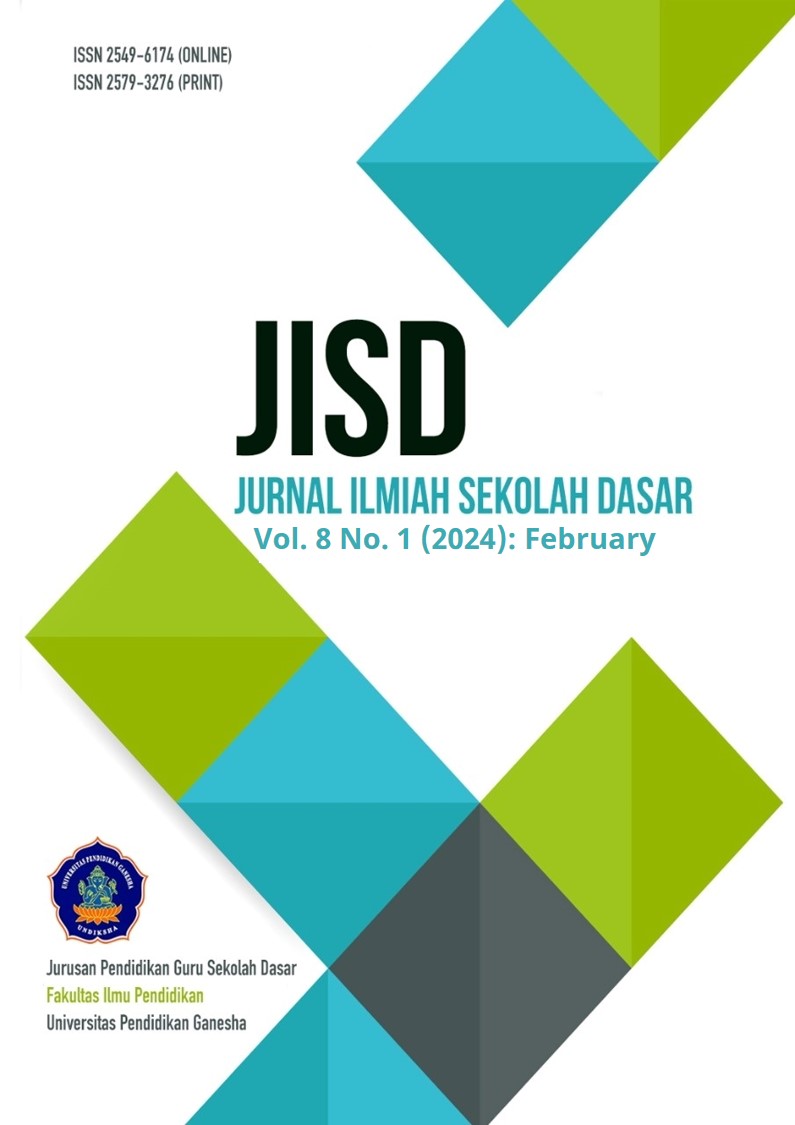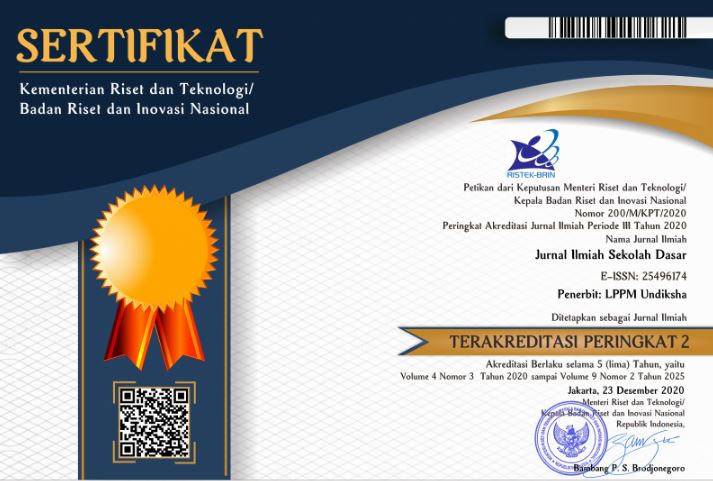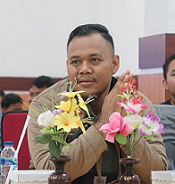The Effectiveness of Virtual Tour Museums on Student Engagement in Social Studies Learning in Elementary Schools
DOI:
https://doi.org/10.23887/jisd.v8i1.67726Keywords:
Virtual Reality, Student Engagement, Social Studies Learning, Primary SchoolAbstract
During the era of digital transformation, the integration of technology into the field of education through teaching methods has become a necessity. This study aims to measure the effectiveness of museum virtual tour media on increasing student involvement in social studies learning in elementary schools. Research design uses quasi-experiment with pre-test and post-test control-group design. The research sample consisted of 64 students in the fifth grade. The dimensions and indicators used in the questionnaire are sourced from The Student Engagement in School Questionnaire (SESQ). The data used in this research comes from questionnaires, interviews, and documentation. The N-gain Score test was chosen to analyse the data, comparing the average scores between the experimental and control groups. The findings show that there is a disparity in the average engagement results between students who use virtual museum tour media and students who use traditional textbooks. The experimental class obtained an n-gain score of 0.683 which indicated an increase in student involvement in the high category, while the control class obtained an n-gain score of 0.193 which indicated an increase in student involvement in the low category. Thus, the use of virtual museum tour media is proven to be able to make a significant contribution in increasing student involvement, encouraging cultural appreciation, and strengthening students' sense of nationalism in elementary schools.
References
Adedoyin, O. B., & Soykan, E. (2023). Covid-19 pandemic and online learning: the challenges and opportunities. Interactive Learning Environments, 31(2), 863–875. https://doi.org/10.1080/10494820.2020.1813180. DOI: https://doi.org/10.1080/10494820.2020.1813180
Al-Ansi, A. M., Jaboob, M., Garad, A., & Al-Ansi, A. (2023). Analyzing augmented reality (AR) and virtual reality (VR) recent development in education. Social Sciences & Humanities Open, 8(1), 100532. https://doi.org/10.3991/ijet. v12i02.6158. DOI: https://doi.org/10.1016/j.ssaho.2023.100532
Allcoat, D., & von Mühlenen, A. (2018). Learning in virtual reality: Effects on performance, emotion and engagement. Research in Learning Technology, 26. https://doi.org/10.1088/1742-6596/1019/1/012064. DOI: https://doi.org/10.25304/rlt.v26.2140
Ariani, L. (2019). Keterlibatan siswa (student engagement) di sekolah sebagai salah satu upaya peningkatan keberhasilan siswa di sekolah. Prosiding Seminar Nasional & Call Pape, Banjarmasin, 13, 103–110. https://doi.org/10.1187/cbe.13-06-0115. DOI: https://doi.org/10.1187/cbe.13-06-0115
Baharun, H., & Nur Aini, L. (2020). Penguatan Pendidikan Aswaja An-Nahdliyah untuk Memperkokoh Sikap Toleransi. Jurnal Islam Nusantara, 04(02), 189–202. https://doi.org/10.33852/jurnalin.v4i2.224.
Bardakci, S., Soylu, M. Y., Akkoyunlu, B., & Deryakulu, D. (2022). Collaborations, concepts, and citations in educational technology: A trend study via bibliographic mapping. Education and Information Technologies, 1–26. https://doi.org/10.1080/10494820.2023.2192757. DOI: https://doi.org/10.1080/10494820.2023.2192757
Billinghurst, M., Clark, A., & Lee, G. (2015). A survey of augmented reality. Foundations and Trends® in Human–Computer Interaction, 8(2–3), 73–272. https://doi.org/10.1561/1100000049. DOI: https://doi.org/10.1561/1100000049
Boyles, B. (2017). Virtual reality and augmented reality in education. Center For Teaching Excellence, United States Military Academy, West Point, Ny, 67. https://doi.org/10.1088/1742-6596/1019/1/012064. DOI: https://doi.org/10.1088/1742-6596/1019/1/012064
Burdea, G. C., & Coiffet, P. (2003). Virtual reality technology. John Wiley & Sons. https://doi.org/10.1080/07377363.2011.583186. DOI: https://doi.org/10.1162/105474603322955950
Fidan, M., & Tuncel, M. (2019). Integrating augmented reality into problem based learning: The effects on learning achievement and attitude in physics education. Computers & Education, 142, 103635. https://doi.org/10.25304/rlt.v28.2355. DOI: https://doi.org/10.1016/j.compedu.2019.103635
Fredricks, J. A., Filsecker, M., & Lawson, M. A. (2016). Student engagement, context, and adjustment: Addressing definitional, measurement, and methodological issues. In Learning and instruction (Vol. 43, pp. 1–4). Elsevier. https://doi.org/10.1016/j.compedu.2020.103819. DOI: https://doi.org/10.1016/j.learninstruc.2016.02.002
Fredricks, J. A., & McColskey, W. (2012). The measurement of student engagement: A comparative analysis of various methods and student self-report instruments. In Handbook of research on student engagement (pp. 763–782). Springer. https://doi.org/10.1080/00461520.2014.989230. DOI: https://doi.org/10.1007/978-1-4614-2018-7_37
Gao, F., Li, L., & Sun, Y. (2020). A systematic review of mobile game-based learning in STEM education. Educational Technology Research and Development, 68, 1791–1827. https://doi.org/10.3991/ijet.v14i07.10315. DOI: https://doi.org/10.1007/s11423-020-09787-0
Giatman, M., Siswati, S., & Basri, I. Y. (2020). Online learning quality control in the pandemic Covid-19 era in Indonesia. Journal of Nonformal Education, 6(2), 168–175. https://doi.org/10.1016/j.compedu.2008.12.020. DOI: https://doi.org/10.1016/j.compedu.2008.12.020
Hart, S. R., Stewart, K., & Jimerson, S. R. (2011). The student engagement in schools questionnaire (SESQ) and the teacher engagement report form-new (TERF-N): Examining the preliminary evidence. Contemporary School Psychology: Formerly" The California School Psychologist", 15(1), 67–79. http://dx.doi.org/10.6007/IJARPED/v12-i2/17203. DOI: https://doi.org/10.1007/BF03340964
Hu-Au, E., & Lee, J. J. (2017). Virtual reality in education: a tool for learning in the experience age. International Journal of Innovation in Education, 4(4), 215–226. https://doi.org/10.3389/frvir.2021.697667. DOI: https://doi.org/10.1504/IJIIE.2017.10012691
Huang, Y., Richter, E., Kleickmann, T., & Richter, D. (2023). Virtual Reality in Teacher Education from 2010 to 2020. Bildung Für Eine Digitale Zukunft, 399–441. https://doi.org/10.4103/2152-7806.80117. DOI: https://doi.org/10.1007/978-3-658-37895-0_16
Jumrana, Partini, & Wastutiningsih, S. P. (2020). Netizen participation in the counter narrative of the anti-hoax movement in Indonesia. International Journal of Innovation, Creativity and Change, 13(1), 569–582. https://doi.org/10.1177/0022487109348479. DOI: https://doi.org/10.1177/0022487109348479
Kamińska, D., Sapiński, T., Wiak, S., Tikk, T., Haamer, R. E., Avots, E., Helmi, A., Ozcinar, C., & Anbarjafari, G. (2019). Virtual reality and its applications in education: Survey. Information, 10(10), 318. https://doi.org/10.3390/info13110525. DOI: https://doi.org/10.3390/info10100318
Kamińska, D., Sapiński, T., Zwoliński, G., Wiak, S., Kucharczyk-Pośpiech, M., & Wilczyński, M. (2020). Virtual Reality as a Tool for Ophthalmic Examination. Current Trends in Biomedical Engineering and Bioimages Analysis: Proceedings of the 21st Polish Conference on Biocybernetics and Biomedical Engineering, 94–106. https://doi.org/10.1007/s10972-014-9418-8. DOI: https://doi.org/10.1007/978-3-030-29885-2_9
Kassab, S. E., Al-Eraky, M., El-Sayed, W., Hamdy, H., & Schmidt, H. (2023). Measurement of student engagement in health professions education: a review of literature. BMC Medical Education, 23(1), 354. https://doi.org/10.1109/VS-Games.2018.8493415. DOI: https://doi.org/10.1186/s12909-023-04344-8
Kavanagh, S., Luxton-Reilly, A., Wuensche, B., & Plimmer, B. (2017). A systematic review of Virtual Reality in education. Themes in Science & Technology Education, 10(2), 85–119. https://doi.org/10.21125/iceri.2016.2170. DOI: https://doi.org/10.21125/iceri.2016.2170
Khan, A., Egbue, O., Palkie, B., & Madden, J. (2017). Active learning: Engaging students to maximize learning in an online course. Electronic Journal of E-Learning, 15(2), pp107-115. https://doi.org/10.53797/aspen.v1i2.15.2021.
Khukalenko, I. S., Kaplan-Rakowski, R., An, Y., & Iushina, V. D. (2022). Teachers’ perceptions of using virtual reality technology in classrooms: A large-scale survey. Education and Information Technologies, 27(8), 11591–11613. https://doi.org/10.34190/ejel.21.4.3060. DOI: https://doi.org/10.1007/s10639-022-11061-0
Lan, M., & Hew, K. F. (2020). Examining learning engagement in MOOCs: A self-determination theoretical perspective using mixed method. International Journal of Educational Technology in Higher Education, 17(1), 1–24. https://doi.org/10.30935/cedtech/10986. DOI: https://doi.org/10.1186/s41239-020-0179-5
Lei, H., Cui, Y., & Zhou, W. (2018). Relationships between student engagement and academic achievement: A meta-analysis. Social Behavior and Personality: An International Journal, 46(3), 517–528. https://doi.org/10.3389/fpsyg.2022.880935. DOI: https://doi.org/10.2224/sbp.7054
Makransky, G., & Lilleholt, L. (2018). A structural equation modeling investigation of the emotional value of immersive virtual reality in education. Educational Technology Research and Development, 66(5), 1141–1164. https://doi.org/10.1080/14703297.2013.820139. DOI: https://doi.org/10.1007/s11423-018-9581-2
Marougkas, A., Troussas, C., Krouska, A., & Sgouropoulou, C. (2023). How personalized and effective is immersive virtual reality in education? A systematic literature review for the last decade. Multimedia Tools and Applications, 1–49. https://doi.org/10.1007/s11042-023-15986-7. DOI: https://doi.org/10.1007/s11042-023-15986-7
Nguyen, V. T., Hite, R., & Dang, T. (2018). Web-based virtual reality development in classroom: From learner’s perspectives. 2018 IEEE International Conference on Artificial Intelligence and Virtual Reality (AIVR), 11–18. https://doi.org/10.3390/mti6090075. DOI: https://doi.org/10.3390/mti6090075
Noetel, M., Parker, P., Dicke, T., Beauchamp, M. R., Ntoumanis, N., Hulteen, R. M., Diezmann, C., Yeung, A., Ahmadi, A., & Vasconcellos, D. (2023). Prediction versus explanation in educational psychology: A cross-theoretical approach to using teacher behaviour to predict student engagement in physical education. Educational Psychology Review, 35(3), 73. https://doi.org/10.1007/s10648-023-09786-6. DOI: https://doi.org/10.1007/s10648-023-09786-6
Nugraha, A. J., Suyitno, H., & Susilaningsih, E. (2017). Analisis Kemampuan Berpikir Kritis Ditinjau dari Keterampilan Proses Sains dan Motivasi Belajar melalui Model PBL. Journal of Primary Education, 6(1), 35–43. https://doi.org/10.37630/jpm.v12i3.627. DOI: https://doi.org/10.37630/jpm.v12i3.627
Oigara, J. N. (2018). Integrating virtual reality tools into classroom instruction. In Handbook of research on mobile technology, constructivism, and meaningful learning (pp. 147–159). IGI Global. https://doi.org/10.1177/0162643420962011. DOI: https://doi.org/10.4018/978-1-5225-3949-0.ch008
Ozili, P. K., & Arun, T. (2023). Spillover of COVID-19: impact on the Global Economy. In Managing inflation and supply chain disruptions in the global economy (pp. 41–61). IGI Global. https://doi.org/10.1080/19397038.2021.1964634. DOI: https://doi.org/10.4018/978-1-6684-5876-1.ch004
Perriguey, G. (2023). Student emotions in virtual reality: The concept of psychopedagogy by design. In Immersive education: Designing for learning (pp. 51–69). Springer. https://doi.org/10.4324/9780203964347. DOI: https://doi.org/10.1007/978-3-031-18138-2_4
Pramana, C., Kurniasari, L., Santoso, B., Afrianty, I., Syahputra, A., Noviyanto, F., Handoko, L., Wulandari, R., & Susilawaty, A. (2020). Knowledge, attitudes, and practices of using masks by the community during the Covid-19 pandemic in Indonesia. PalArch’s Journal of Archaeology of Egypt/Egyptology, 17(9). https://doi.org/10.1016/j.ijsu.2020.04.018. DOI: https://doi.org/10.1016/j.ijsu.2020.04.018
Putria, H., Maula, L. H., & Uswatun, D. A. (2020). Analisis proses pembelajaran dalam jaringan (daring) masa pandemi covid-19 pada guru sekolah dasar. Jurnal Basicedu, 4(4), 861–870. https://doi.org/10.1016/j.scitotenv.2020.138870. DOI: https://doi.org/10.31004/basicedu.v4i4.460
Reilly, J. M., & Dede, C. (2019). Augmented Reality in Education. Handbook of Mobile Teaching and Learning: Second Edition, figure 1, 1337–1351. https://doi.org/10.1007/978-981-13-2766-7_126. DOI: https://doi.org/10.1007/978-981-13-2766-7_126
Risdianto, E. (2019). Development of Blended Learning based on Web and Augmented Reality. 295(ICETeP 2018), 144–147. https://doi.org/10.2991/icetep-18.2019.35. DOI: https://doi.org/10.2991/icetep-18.2019.35
Scheiter, K., Schubert, C., Schüler, A., Schmidt, H., Zimmermann, G., Wassermann, B., Krebs, M.-C., & Eder, T. (2019). Adaptive multimedia: Using gaze-contingent instructional guidance to provide personalized processing support. Computers & Education, 139, 31–47. https://doi.org/10.1080/08923647.2016.1119621. DOI: https://doi.org/10.1016/j.compedu.2019.05.005
Tilaar, A. L. F. (2019). The Influence of the Application of Mathematics Learning Performance Assessment and Portfolio Assessment toward Senior Highschool Students’ Mathematics Achievement. International Journal of Innovative Science and Research Technology (IJISRT), 4(2), 457–466. https://doi.org/10.1145/3337722.3341831. DOI: https://doi.org/10.1145/3337722.3341831
Tilovberdiyevich, X. A. (2023). Virtual Reality in Education (On the Example of Applications). Journal of Pedagogical Inventions and Practices, 16, 29–31. https://doi.org/10.1111/bjop.12305. DOI: https://doi.org/10.1111/bjop.12305
Van Lieshout, M., Egyedi, T. M., & Bijker, W. E. (2018). Social Learning in Educational Multimedia. In Social Learning Technologies (pp. 281–312). Routledge. https://doi.org/10.1186/s40561-020-00142-7. DOI: https://doi.org/10.4324/9781315204659
Yang, D., Chen, P., Wang, K., Li, Z., Zhang, C., & Huang, R. (2023). Parental Involvement and Student Engagement: A Review of the Literature. Sustainability, 15(7), 5859. https://doi.org/10.3390/su15075859. DOI: https://doi.org/10.3390/su15075859
Downloads
Published
How to Cite
Issue
Section
License
Copyright (c) 2024 Freddy Widya Ariesta, Bunyamin Maftuh , Sapriya, Ernawulan Syaodih

This work is licensed under a Creative Commons Attribution-ShareAlike 4.0 International License.
Authors who publish with the Journal Ilmiah Sekolah Dasar agree to the following terms:
- Authors retain copyright and grant the journal the right of first publication with the work simultaneously licensed under a Creative Commons Attribution License (CC BY-SA 4.0) that allows others to share the work with an acknowledgment of the work's authorship and initial publication in this journal.
- Authors are able to enter into separate, additional contractual arrangements for the non-exclusive distribution of the journal's published version of the work (e.g., post it to an institutional repository or publish it in a book), with an acknowledgment of its initial publication in this journal.
- Authors are permitted and encouraged to post their work online (e.g., in institutional repositories or on their website) prior to and during the submission process, as it can lead to productive exchanges, as well as earlier and greater citation of published work. (See The Effect of Open Access)










